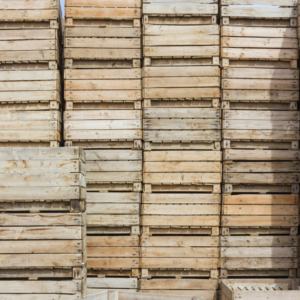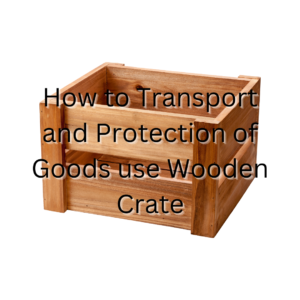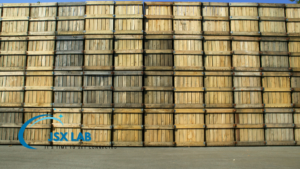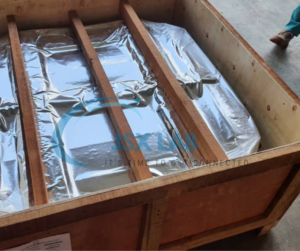Pallet
How Do You Calculate CBM?
What Is CBM And How Do You Calculate It?
Find out what CBM is and how to calculate CBM for your cargo. Learn to calculate CBM for Ocean Freight, Air Freight and road freight. Calculate CBMs per pallet.
In the business of shipping goods from one country to another by air, sea or road, you often hear the term CBM being used. Short for “cubic meter”, CBM is a widely used unit of measurement in shipping and determines how much you pay for freight.
In this piece, we’ve compiled everything you need to know about CBM so that you can measure your cargo accurately and determine your shipping costs. Read on to know:
- What is CBM?
- How do you calculate CBM?
- What are Volumetric Weight and Chargeable Weight?
- How do you calculate freight using CBM?
- How many CBMs in a container?
- How many CBMs in a pallet?
- How do you calculate CBM for irregularly shaped packages?
- How does CBM impact freight rates?
What is CBM?
A cubic meter or CBM is a measurement of the volume of a shipment. It determines how much space your cargo will take up on a ship, aircraft or truck, which in turn will decide how much it will cost to transport.
Read: Why Wooden Crates as Industrial Shipping Crates?
How do you calculate CBM?
Length x Width x Height = CBM
This is the formula used to measure your cargo volume in CBM (m³).
Say, you have a carton that is 2 meters in length x 2 meters wide x 2 meters high. Then, its volume is: 2 x 2 x 2 = 8 m³.
And if you have 10 such identical cartons in a single consignment, you can simply multiply the CBM with the total number of cartons to arrive at the total volume – 8 x 10 = 80 m³.
If the cartons are not of the same size, calculate the CBM for each carton by using the same formula and adding up the total.

What are Volumetric Weight and Chargeable Weight?
In shipping, volume (CBM) is one way of calculating freight. The other is weight. Traditionally, the weight of a shipment is said to decide its transportation cost. But what if the shipment is extremely light but has a large volume (a carton of styrofoam cups or a bale of cotton wool, for example)? Such a shipment would take up more space than, say, a shipment of small steel items. But if freight is charged on the basis of its light weight, the amount would be nominal. This is where a concept called dimensional or volumetric weight and the chargeable weight comes in.
Gross Weight: This is the actual weight of your cargo, including any packaging, cushioning and pallets.
Dimensional/Volumetric Weight: The volume of cargo converted into its weight equivalent (CBM to kg) is called dimensional weight or volumetric weight. Depending on the freight mode (air, sea, road) and carrier, dimensional weight can be calculated using either of these formulas:
- CBM x DIM Factor = Dimensional Weight
- Length (cm) x Width (cm) x Height (cm) x Quantity / DIM Factor = Dimensional Weight
Quantity is the number of packages that makes up a single cargo consignment.
The DIM factor, or dimensional weight factor, varies according to freight mode (sea, air, courier, truck) and carrier. Generally accepted DIM factors are:
- Sea freight – 1:1,000 (1 m³ = 1,000 kg or 1 ton)
- Air freight – 1:6,000 (1 m³ = 6,000 kg or 6 tons). But when we use the first formula (CBM x DIM Factor = Dimensional Weight), then the DIM factor is 1:167, where 1 m³ = 167 kg.
- Courier/Express freight – 1:5,000 (1 m³ = 5,000 kg or 5 tons)
- Road freight (less than truckload or LTL) – 1:3,000 (1 m³ = 3,000 kg or 3 tons.
Note: Though the DIM factors mentioned here are widely accepted, they might still vary across freight modes, service providers and regions, so check what is applicable in your case.
Chargeable weight: Once you have both your gross weight and dimensional weight, your freight service provider will charge you on the basis of whichever of the two is greater. This is called chargeable weight. If gross weight is greater than dimensional weight, you will be charged on the basis of the former. But if the dimensional weight is greater, that will be the chargeable weight.

How to calculate freight using CBM
1. For LCL ocean freight
Say, you are sending a less than container load (LCL) shipment by sea. (LCL shipping is a mode of transporting moderate volumes of cargo in a shared container). Shipping lines charge freight on the basis of CBM mostly for LCL shipments, provided they weigh less than one ton (1,000 kg). If the cargo weighs over a ton, then freight is charged on the basis of weight.
Example 1
Package dimensions: 4 m x 4 m x 4 m
CBM: 4 x 4 x 4 = 64 m³
DIM factor: 1:1,000
Gross weight: 200 kg (0.2 ton)
Freight rate: $50 per CBM/ton
Since volume (CBM) is greater than actual weight, freight will be charged on the basis of CBM. Hence, freight cost: 50 x 64 = $3,200
Example 2
Package dimensions: 2 m x 2 m x 1 m
CBM: 2 x 2 x 1 = 4 m³
DIM factor: 1:1,000
Gross weight: 5,500 kg (5.5 ton)
Freight rate: $50 per CBM/ton
Since gross weight is greater than volume, freight will be charged on the basis of gross weight. Hence, freight cost: 50 x 5.5 = $275
2. For air freight
Here, we have used the second formula to calculate dimensional weight – Length (cm) x Width (cm) x Height (cm) / DIM Factor – and a DIM factor of 1:6,000 to arrive at freight cost.
Example 1
Freight rate: $150 per CBM/ton
Package dimensions: 150 cm X 100 cm X 100 cm
Gross weight: 200 kg (0.2 ton)
Dimensional weight: 150 x 100 x 100 / 6,000 = 250 kg (0.25 ton)
Chargeable weight is dimensional weight (250 kg), which is greater than gross weight (200 kg). Hence, freight cost: 0.25 x 150 = $37.50
Example 2
Freight rate: $150 per CBM/ton
Package dimensions: 50 cm X 80 cm X 60 cm
Gross weight: 1,200 kg (1.2 ton)
Dimensional weight: 50 x 80 x 60 / 6,000 = 40 kg (0.04 ton)
Chargeable weight is gross weight (1,200 kg), which is greater than dimensional weight (40 kg). Hence, freight cost: 1.2 x 150 = $180
3. For road freight
This calculation is based on the formula Length (cm) x Width (cm) x Height (cm) / DIM Factor for dimensional weight, using a DIM factor of 1:3,000.
Freight rate: $60 per CBM/ton
Package dimensions: 150 cm x 80 cm x 60 cm
Dimensional weight: 150 x 80 x 60 / 3,000 = 240 kg (0.24 ton)
Gross weight: 175 kg (0.175 ton)
Dimensional weight (240 kg), which is greater than gross weight (175 kg), is the chargeable weight. Hence, freight cost: 0.24 x 60 = $15
Note: Freight rates mentioned in the examples above are representational. For actual and current rates, contact your freight forwarder or get instant quotes on JSX Lab.

How many CBMs in a container?
With many of us using containers to ship our goods, it’s important to know how many CBMs can be accommodated in a standard 20-foot, 40-foot and 45-foot container:Note: HC means High Cube; Payload is the maximum cargo weight a container can hold
How many CBMs in a pallet?
Like containers, pallets – flat structures used to support and secure cargo – come in standard sizes. The most common ones are the 48’’ x 40’’, 42’’ x 42’’ and 48’’ x 48’’ 1 pallet. One of these standard pallets can accommodate 1.26 m³.
JSX Lab can customize all wooden pallets for different industries to deliver your goods worldwide.
Read: Pallets in Johor Bahru, Malaysia and Singapore
How do you calculate CBM for irregularly shaped packages?
All the dimensions and calculations mentioned so far in this article have been for packages with a regular shape, such as a cube or cuboid. A carton is a package with a regular shape, for which the formula is Length x Width x Height = CBM. But what if your package has an irregular shape? How do you measure its CBM?
1. Cylindrical package:
A rolled carpet or a pipe, for example. Set the package upright and measure its height and radius (which is half of its diameter). Measurements should be in metres. Now use the formula π x r ² x h = CBM, where
- π is the symbol for pi, which is the ratio of the circumference to the diameter of a circle, conventionally equal to 3.14
- r is the radius
- h is the height (which is equal to the length)
2. Irregularly shaped package:
To measure the CBM of such a package, measure its longest length, longest width and longest height. Then use the formula Length (max) x Width (max) x Height (max) = CBM.
Measurements and conversions
Since CBM is calculated in meters, here’s how you can convert your cargo measurements into meters:
- Foot to meter: 1 foot equals 0.3048 meters, so multiply the foot value by 0.3048
- Inch to meter: 1 inch equals 0.0254 meters, so multiply by 0.0254
- Centimeter to meter: 1 centimeter equals 0.01 meters, so multiply by 0.01
How does CBM impact freight rates?
When we say that cargo volume or CBM determines your freight cost, we’re not just talking about the carrier’s charges for transporting your goods. When you receive a freight quote, it includes many other charges and surcharges, all or some of which might also be calculated on the basis of CBM. These include:
- Terminal handling charges: These are costs associated with the use of equipment and property owned by terminals at the origin and destination and the use of labor provided by them for the loading/unloading of cargo and their transport.
- Inland haulage charges: These are costs associated with the movement of cargo from the inland container depot/container freight station to the port of loading or vice-versa.
- Bunker Adjustment Factor (BAF): Also called Fuel Adjustment Factor, this is an additional charge levied by carriers to account for fuel price fluctuations.
Currency Adjustment Factor (CAF): This is a surcharge levied by carriers to compensate for currency rate fluctuations to the base exchange rate.
JSX Lab No.1 Wooden Pallet supplier in Malaysia Johor and Singapore.
We offer the best quality wood pallets, plastic pallets and plywood online at the best price to our Malaysia Johor Bahru and Singapore customers. Simply visit our Shop section to access our secure checkout. We offer a variety of standard New and recycling wooden pallets. These pallets are great for shipping and are also great for storage. To speak with our team, you can call us at +6012 727 0188. Because we understand that each customer has a different budget, we work closely to find the best solution.
To learn more about our prices, request a quote today. Simply fill out the contact form to send us your details and specifications. We will get back to you as soon as possible with a custom price.
All JSX Lab pallets have been Heat Treated with ISPM 15 certified. You can browse our entire range of pallet sizes and types to find the right one for you. Secure delivery is available for all orders. We deliver to Singapore and Malaysia. If you need bulk orders or have questions, please feel free to contact our team.
whatsapp








